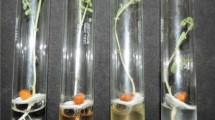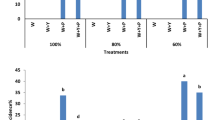Abstract
Occurrence of salt stress with the soil borne fungus Fusarium oxysporum f. sp. cepa (FOC) are potential threat to the crop yield. This investigation reports effect of the concurrent stresses (salinity and FOC) on morpho-physiological and yield attributes in onion. In vitro growth tests revealed proliferation of FOC biomass at different levels of salinity (2–8 dS m−1). A greenhouse pot experiment with the proposed levels of salinity (2.5, 3.5 and 4.5 dS m−1) in combination with FOC inoculation showed more drastic effect of combined stress on disease severity, plant growth and bulb as compared to the individual stress. In general, osmotic potential, total chlorophyll content, membrane stability index and total protein content of the leaf were decreased, while total phenolics were increased due to the given stress/s. Total sugar content decreased due to effect of the individual stress of FOC, while it increased under the individual stress of salinity and in combination with FOC. FOC infection did not change activity of polyphenol oxidase (PPO), while it improved peroxidase (POX) and phenylalanine ammonia lyase (PAL) and decreased catalase (CAT) activity. Activities of POX and PPO increased, however PAL and CAT declined under individual as well as simultaneous stress of salinity and FOC. The research work concluded that FOC will be a more severe disease threat for onion cultivation in saline soils.




Similar content being viewed by others
References
Amirjani MR (2011) Effect of salinity stress on growth, sugar content, pigments and enzyme activity of rice. Int J Bot 7:73–81
Bartoli CG, Casalongué CA, Simontacchi M, Marquez-Garcia B, Foyer CH (2013) Interactions between hormone and redox signaling pathways in the control of growth and cross-tolerance to stress. Environ Exp Bot 94:73–88
Boumaaza B, Benkhelifa M, Belkhoudja M (2015) Effects of two salts compounds on mycelial growth, sporulation, and spore germination of six isolates of Botrytis cinerea in the Western North of Algeria. Int J microbiol 2015:1–8
Bouyoucos GJ (1962) Hydrometer method improved for making particle size analysis of soil. Agron J 54:464–465
Cachorro P, Martinez R, Ortiz A, Cerda A (1995) Abscisic acid and osmotic relations in (Phaseolus vulgaris L.) under saline conditions. Plant Sci 95:29–32
Capell B, Dörffling K (1993) Genotype-specific differences in chilling tolerance of maize in relation to chilling-induced changes in water status and abscisic acid accumulation. Physiol Plant 88:638–646
Coşkuntuna A, Özer N (2008) Biological control of onion basal rot disease using Trichoderma harzianum and induction of antifungal compounds in onion set following seed treatment. Crop Prot 27:330–336
Cramer CS (2000) Breeding and genetics of fusarium basal rot resistance in onion. Euphytica 115:159–166
Dickerson DP, Pascholati SF, Hagerman AE, Butler LG, Nicholson RL (1984) Phenylalanine ammonia-lyase and hydroxycinnamate: CoA ligase in maize mesocotyls inoculated with Helminthosporium maydis or Helminthosporium carbonum. Physiol Plant Pathol 25:111–123
FAO (2013) The Food and Agriculture Organization. FAO Global Aquaculture Production Volume and Value Statistics Database Updated to 2012
Farag AA (2009) Increasing tolerance of Vigna sinensis L. to salt stress using an organic acid and a polyamine. M.Sc. thesis. Ain Shams University, Cairo, Eygpt
Gechev TS, Van Breusegem F, Stone JM, Denev I, Laloi C (2006) Reactive oxygen species as signals that modulate plant stress responses and programmed cell death. BioEssays 28:1091–1101
Gholizadeh A, Kohnehrouz BB (2010) Activation of phenylalanine ammonia lyase as a key component of the antioxidative system of salt-challenged maize leaves. Braz J Plant Physiol 22:217–223
Giuffrida F, Scuderi D, Giurato R, Leonardi C (2013) Physiological response of broccoli and cauliflower as affected by NaCl salinity. Acta Hortic 1005:435–441
Kaushik D, Roychoudhury A (2014) Reactive oxygen species (ROS) and response of antioxidants as ROS-scavengers during environmental stress in plants. Front Environ Sci. https://doi.org/10.3389/fenvs.2014.00053
Kumar KB, Khan PA (1983) Age-related changes in catalase and peroxidase activities in the excised leaves of Eleusine coracana Gaertn. cv PR 202 during senescence. Exp Gerontol 18:409–417
Lichtenthaler H, Wellburn A (1983) Determinations of total carotenoids and chlorophylls b of leaf extracts in different solvents. Biochem Soc Trans 11:591–592
Lowry OH, Rosebrough NJ, Farr AL, Randall RJ (1951) Protein measurement with the Folin phenol reagent. J Biol Chem 193:265–275
Machado RM, Serralheiro RP (2017) Soil salinity: Effect on vegetable crop growth. Management practices to prevent and mitigate soil salinization. Horticulturae 3:30
Maehly AC (1954) The assay of catalases and peroxidases. Methods Biochem Anal 1:357–424
Mahboob W, Khan MA, Shirazi MU (2016) Induction of salt tolerance in wheat (Triticum aestivum L.) seedlings through exogenous application of proline. Pak J Bot 48:861–8677
Makhloufi E, Yousfi FE, Marande W, Mila I, Hanana M, Bergs H, Mzid R, Bouzayen M (2014) Isolation and molecular characterization of ERF1, an ethylene response factor gene from durum wheat (Triticum turgidum L. subsp. durum), potentially involved in salt-stress responses. J Exp Bot 65:6359–6371
Mayer AM, Harel E, Ben-Shaul R (1966) Assay of catechol oxidase—a critical comparison of methods. Phytochemistry 5:783–789
Mazher AMA, El-Quesni EMF, Farahat MM (2007) Responses of ornamental and woody trees to salinity. World J Agric Sci 3:386–395
McLean EO (1982) Soil pH and lime requirement. In: Page AL (ed) Methods of soil analysis, part 2. Chemical and microbiological properties. American Society of Agronomy, Soil Science Society of America Journal, Madison, pp 199–223
Mittler R, Blumwald E (2010) Genetic engineering for modern agriculture: challenges and perspectives. Ann Rev Plant Biol 61:443–462
Mittova V, Guy M, Tal M, Volokita M (2004) Salinity upregulates the antioxidative system in root mitochondria and peroxisomes of the wild salt-tolerant tomato species Lycopersicon pennellii. J Exp Bot 55:1105–1113
Nelson N (1944) A photometric adaptation of Somogyi method for the determination of glucose. J Biol Chem 3:375–380
Palma JM, Sandalio LM, Javier CF, Romero-Puertas MC, McCarthy I, Del Río LA (2002) Plant proteases, protein degradation, and oxidative stress: role of peroxisomes. Plant Physiol Biochem 40:521–530
Pandey P, Irulappan V, Bagavathiannan MV, Senthil-Kumar M (2017) Impact of combined abiotic and biotic stresses on plant growth and avenues for crop improvement by exploiting physio-morphological traits. Front Plant Sci 8:537
Pang HC, Li YY, Yang JS, Liang YS (2010) Effect of brackish water irrigation and straw mulching on soil salinity and crop yields under monsoonal climatic conditions. Agric Water Manag 97:1971–1977
Regragui A, Lahlou H (2005) Effect of salinity on in vitro Trichoderma harzianum antagonism against Verticillium dahliae. Pak J Biol Sci 8:872–876
Reid TC, Hausbeck MK, Kizilkaya K (2001) Effects of sodium chloride on commercial asparagus and of alternative forms of chloride salt on Fusarium crown and root rot. Plant Dis 85:1271–1275
Rice-Evans CA, Miller NJ, Paganga G (1996) Structure-antioxidant activity relationships of flavonoids and phenolic acids. Free Radic Biol Med 20:933–956
Richards L (1954) Diagnosis and improvement of saline and alkali soils. Agriculture Handbook No 60 United States
Roussos P, Gasparatos D, Kyriakou C, Tsichli K, Tsantili E, Haidouti C (2013) Growth, nutrient status and biochemical changes in sour orange (Citrus aurantium L.) plants subjected to sodium chloride stress. Cοmmun Soil Sci Plant Anal 44:805–816
Sagot B, Gaysinski M, Mehiri M, Guigonis JM, Le Rudulier D, Alloing G (2010) Osmotically induced synthesis of the dipeptide N-acetylglutaminylglutamine amide is mediated by a new pathway conserved among bacteria. Proc Natl Acad Sci 107:12652–12657
Saneoka H, Moghaieb REA, Premachandra GS, Fujita K (2004) Nitrogen nutrition and water stress effects on cell membrane stability and leaf water relations in Agrostis palustris Huds. Environ Exp Bot 52:131–138
Sasaki K, Nakahara K, Tanaka S, Shigyo M, Ito S (2015) Genetic and pathogenic variability of Fusarium oxysporum f. sp. cepae Isolated from onion and welsh onion in Japan. Phytopathology 105:525–532
Saxena A, Cramer CS (2009) Screening of onion seedlings for resistance against New Mexico isolates of Fusarium oxysporum f. sp. cepae. J Plant Pathol 91:199–202
Seckin B, Sekmen AH, Türkan I (2009) An enhancing effect of exogenous mannitol on the antioxidant enzyme activities in roots of wheat under salt stress. J Plant Growth Regul 28:12–20
Shahid MA, Balal RM, Pervez MA, Abbas T, Ashfaq M, Ghazanfar U, Afzal M, Rashid A, Garcia-Sanchez F, Mattson NS (2012) Differential response of pea (Pisum sativum L.) genotypes to salt stress in relation to the growth, physiological attributes antioxidant activity and organic solutes. Aust J Crop Sci 6:828–838
Szabados L, Savouré A (2010) Proline: a multifunctional amino acid. Trends Plant Sci 15:89–97
Türkkan M, Erper I (2013) Evaluation of antifungal activity of sodium salts against. Plant Protect Sci 50:19–25
Van Alfen NK, Turner NC (1975) Influence of a Ceratocystis ulmi toxin on water relations of Elm (Ulmus americana). Plant Physiol 55:312–316
Walkley A (1947) A critical examination of a rapid method for determining organic carbon in soils—effect of variations in digestion conditions and of inorganic soil constituents. Soil Sci 63:251–264
Wang M, Sun Y, Sun G, Liu X, Zhai L, Shen Q, Guo S (2015) Water balance altered in cucumber plants infected with Fusarium oxysporum f. sp. cucumerinum. Sci Rep 5:1–7
Weisany W, Sohrabi Y, Heidari G, Siosemardeh A, Ghassemi-Golezani K (2012) Changes in antioxidant enzymes activity and plant performance by salinity stress and zinc application in soybean (Glycine max L.). Plant Omics J 5:60–67
Wichern J, Wichern F, Joergensen RG (2006) Impact of salinity on soil microbial communities and the decomposition of maize in acidic soils. Geoderma 137:100–108
Yamane K, Mitsuya S, Taniguchi M, Miyake H (2010) Transcription profiles of genes encoding catalase and ascorbate peroxidase in the rice leaf tissues under salinity. Plant Prod Sci 13:164–168
You MP, Colmer TD, Barbetti MJ (2011) Salinity drives host reaction in Phaseolus vulgaris (common bean) to Macrophomina phaseolina. Funct Plant Biol 38:984–992
Youssef T, Awad MA (2008) Mechanisms of enhancing photosynthetic gas exchange in date palm seedlings (Phoenix dactylifera L.) under salinity stress by a 5-aminolevulinic acid based fertilizer. J Plant Growth Regul 27:1–9
Zhu JK (2001) Plant salt tolerant. Trends plant Sci 6:66–71
Acknowledgements
Authors are thankful to the University of the Punjab for providing funds to accomplish this research work.
Author information
Authors and Affiliations
Corresponding author
Rights and permissions
About this article
Cite this article
Shoaib, A., Meraj, S., Nafisa et al. Influence of salinity and Fusarium oxysporum as the stress factors on morpho-physiological and yield attributes in onion. Physiol Mol Biol Plants 24, 1093–1101 (2018). https://doi.org/10.1007/s12298-018-0570-z
Received:
Revised:
Accepted:
Published:
Issue Date:
DOI: https://doi.org/10.1007/s12298-018-0570-z




